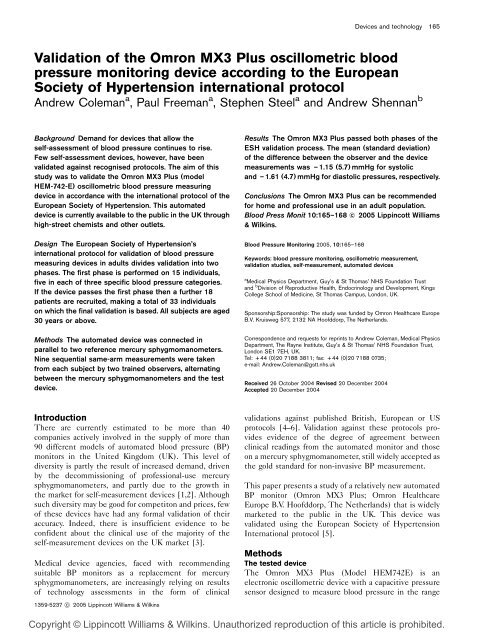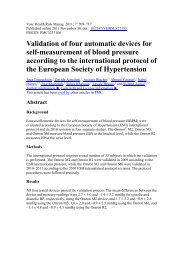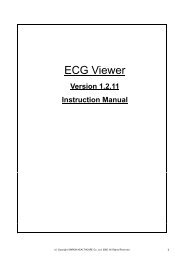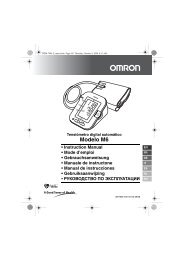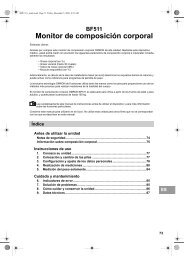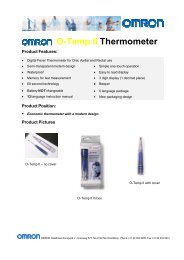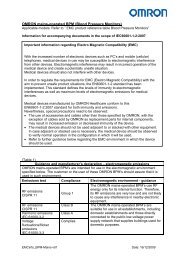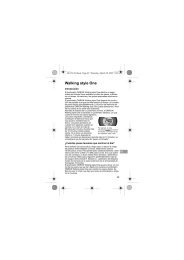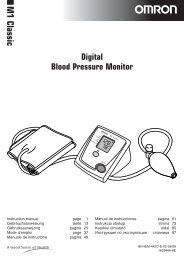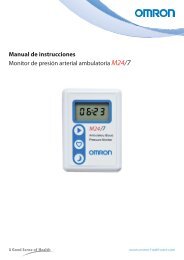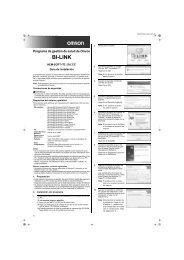Validation of the Omron MX3 Plus oscillometric blood pressure ...
Validation of the Omron MX3 Plus oscillometric blood pressure ...
Validation of the Omron MX3 Plus oscillometric blood pressure ...
You also want an ePaper? Increase the reach of your titles
YUMPU automatically turns print PDFs into web optimized ePapers that Google loves.
Devices and technology 165<br />
<strong>Validation</strong> <strong>of</strong> <strong>the</strong> <strong>Omron</strong> <strong>MX3</strong> <strong>Plus</strong> <strong>oscillometric</strong> <strong>blood</strong><br />
<strong>pressure</strong> monitoring device according to <strong>the</strong> European<br />
Society <strong>of</strong> Hypertension international protocol<br />
Andrew Coleman a , Paul Freeman a , Stephen Steel a and Andrew Shennan b<br />
Background Demand for devices that allow <strong>the</strong><br />
self-assessment <strong>of</strong> <strong>blood</strong> <strong>pressure</strong> continues to rise.<br />
Few self-assessment devices, however, have been<br />
validated against recognised protocols. The aim <strong>of</strong> this<br />
study was to validate <strong>the</strong> <strong>Omron</strong> <strong>MX3</strong> <strong>Plus</strong> (model<br />
HEM-742-E) <strong>oscillometric</strong> <strong>blood</strong> <strong>pressure</strong> measuring<br />
device in accordance with <strong>the</strong> international protocol <strong>of</strong> <strong>the</strong><br />
European Society <strong>of</strong> Hypertension. This automated<br />
device is currently available to <strong>the</strong> public in <strong>the</strong> UK through<br />
high-street chemists and o<strong>the</strong>r outlets.<br />
Design The European Society <strong>of</strong> Hypertension’s<br />
international protocol for validation <strong>of</strong> <strong>blood</strong> <strong>pressure</strong><br />
measuring devices in adults divides validation into two<br />
phases. The first phase is performed on 15 individuals,<br />
five in each <strong>of</strong> three specific <strong>blood</strong> <strong>pressure</strong> categories.<br />
If <strong>the</strong> device passes <strong>the</strong> first phase <strong>the</strong>n a fur<strong>the</strong>r 18<br />
patients are recruited, making a total <strong>of</strong> 33 individuals<br />
on which <strong>the</strong> final validation is based. All subjects are aged<br />
30 years or above.<br />
Methods The automated device was connected in<br />
parallel to two reference mercury sphygmomanometers.<br />
Nine sequential same-arm measurements were taken<br />
from each subject by two trained observers, alternating<br />
between <strong>the</strong> mercury sphygmomanometers and <strong>the</strong> test<br />
device.<br />
Results The <strong>Omron</strong> <strong>MX3</strong> <strong>Plus</strong> passed both phases <strong>of</strong> <strong>the</strong><br />
ESH validation process. The mean (standard deviation)<br />
<strong>of</strong> <strong>the</strong> difference between <strong>the</strong> observer and <strong>the</strong> device<br />
measurements was – 1.15 (5.7) mmHg for systolic<br />
and – 1.61 (4.7) mmHg for diastolic <strong>pressure</strong>s, respectively.<br />
Conclusions The <strong>Omron</strong> <strong>MX3</strong> <strong>Plus</strong> can be recommended<br />
for home and pr<strong>of</strong>essional use in an adult population.<br />
Blood Press Monit 10:165–168 c 2005 Lippincott Williams<br />
& Wilkins.<br />
Blood Pressure Monitoring 2005, 10:165–168<br />
Keywords: <strong>blood</strong> <strong>pressure</strong> monitoring, <strong>oscillometric</strong> measurement,<br />
validation studies, self-measurement, automated devices<br />
a Medical Physics Department, Guy’s & St Thomas’ NHS Foundation Trust<br />
and b Division <strong>of</strong> Reproductive Health, Endocrinology and Development, Kings<br />
College School <strong>of</strong> Medicine, St Thomas Campus, London, UK.<br />
Sponsorship:Sponsorship: The study was funded by <strong>Omron</strong> Healthcare Europe<br />
B.V. Kruisweg 577, 2132 NA Ho<strong>of</strong>ddorp, The Ne<strong>the</strong>rlands.<br />
Correspondence and requests for reprints to Andrew Coleman, Medical Physics<br />
Department, The Rayne Institute, Guy’s & St Thomas’ NHS Foundation Trust,<br />
London SE1 7EH, UK.<br />
Tel: + 44 (0)20 7188 3811; fax: + 44 (0)20 7188 0735;<br />
e-mail: Andrew.Coleman@gstt.nhs.uk<br />
Received 26 October 2004 Revised 20 December 2004<br />
Accepted 20 December 2004<br />
Introduction<br />
There are currently estimated to be more than 40<br />
companies actively involved in <strong>the</strong> supply <strong>of</strong> more than<br />
90 different models <strong>of</strong> automated <strong>blood</strong> <strong>pressure</strong> (BP)<br />
monitors in <strong>the</strong> United Kingdom (UK). This level <strong>of</strong><br />
diversity is partly <strong>the</strong> result <strong>of</strong> increased demand, driven<br />
by <strong>the</strong> decommissioning <strong>of</strong> pr<strong>of</strong>essional-use mercury<br />
sphygmomanometers, and partly due to <strong>the</strong> growth in<br />
<strong>the</strong> market for self-measurement devices [1,2]. Although<br />
such diversity may be good for competiton and prices, few<br />
<strong>of</strong> <strong>the</strong>se devices have had any formal validation <strong>of</strong> <strong>the</strong>ir<br />
accuracy. Indeed, <strong>the</strong>re is insufficient evidence to be<br />
confident about <strong>the</strong> clinical use <strong>of</strong> <strong>the</strong> majority <strong>of</strong> <strong>the</strong><br />
self-measurement devices on <strong>the</strong> UK market [3].<br />
Medical device agencies, faced with recommending<br />
suitable BP monitors as a replacement for mercury<br />
sphygmomanometers, are increasingly relying on results<br />
<strong>of</strong> technology assessments in <strong>the</strong> form <strong>of</strong> clinical<br />
1359-5237 c 2005 Lippincott Williams & Wilkins<br />
validations against published British, European or US<br />
protocols [4–6]. <strong>Validation</strong> against <strong>the</strong>se protocols provides<br />
evidence <strong>of</strong> <strong>the</strong> degree <strong>of</strong> agreement between<br />
clinical readings from <strong>the</strong> automated monitor and those<br />
on a mercury sphygmomanometer, still widely accepted as<br />
<strong>the</strong> gold standard for non-invasive BP measurement.<br />
This paper presents a study <strong>of</strong> a relatively new automated<br />
BP monitor (<strong>Omron</strong> <strong>MX3</strong> <strong>Plus</strong>; <strong>Omron</strong> Healthcare<br />
Europe B.V. Ho<strong>of</strong>ddorp, The Ne<strong>the</strong>rlands) that is widely<br />
marketed to <strong>the</strong> public in <strong>the</strong> UK. This device was<br />
validated using <strong>the</strong> European Society <strong>of</strong> Hypertension<br />
International protocol [5].<br />
Methods<br />
The tested device<br />
The <strong>Omron</strong> <strong>MX3</strong> <strong>Plus</strong> (Model HEM742E) is an<br />
electronic <strong>oscillometric</strong> device with a capacitive <strong>pressure</strong><br />
sensor designed to measure <strong>blood</strong> <strong>pressure</strong> in <strong>the</strong> range<br />
Copyright © Lippincott Williams & Wilkins. Unauthorized reproduction <strong>of</strong> this article is prohibited.
166 Blood Pressure Monitoring 2005, Vol 10 No 3<br />
0–299 mmHg and pulse rates in <strong>the</strong> range 40–180 beats<br />
per min. The specified device accuracy for <strong>the</strong>se two<br />
measurements is ± 3 mmHg and ± 5% <strong>of</strong> <strong>the</strong> display<br />
reading respectively. Systolic <strong>blood</strong> <strong>pressure</strong>, diastolic<br />
<strong>blood</strong> <strong>pressure</strong> and pulse rate are all displayed on a digital<br />
readout. The inflation is by automatic pumping system<br />
and deflation is controlled by automatic <strong>pressure</strong> release<br />
valve.<br />
The unit is powered by an AC adaptor or four 1.5 V<br />
alkaline batteries (type LR6 AA) and weighs 350 g<br />
(without batteries). It measures 118 mm 90 mm <br />
130 mm (width, height and depth, respectively) and is<br />
supplied with a cuff <strong>of</strong> dimensions 145 mm 480 mm<br />
(width and length respectively). The standard cuff is<br />
applicable to arm circumferences in <strong>the</strong> range 220–<br />
320 mm. An optional additional large cuff <strong>of</strong> dimensions<br />
174 mm 617 mm is available for arm circumferences in<br />
<strong>the</strong> range 320–420 mm.<br />
Device validation<br />
A validation team was appointed for <strong>the</strong> study. This team<br />
consisted <strong>of</strong> a medically qualified expert, who provided<br />
clinical oversight and supervision, along with two clinical<br />
scientists and a technician, who recruited patients and<br />
acted as observers, undertaking <strong>the</strong> intercomparison<br />
between <strong>the</strong> automated and mercury devices. The team<br />
members were full-time hospital staff and operate<br />
validations as part <strong>of</strong> <strong>the</strong>ir designated duties. A healthcare<br />
assistant was employed to act as an additional observer<br />
when required. All those involved as observers were<br />
trained using <strong>the</strong> CD-ROM tutorial on <strong>the</strong> British<br />
Hypertension Society Website [7]. Their competence<br />
was assessed as described in <strong>the</strong> British Hypertension<br />
Society protocol [4].<br />
Approval for <strong>the</strong> study was obtained from <strong>the</strong> local<br />
research ethics committee. The subjects, aged 30 years<br />
and above, were recruited from patients attending routine<br />
hypertension clinics at Guy’s & St Thomas’ Hospital<br />
NHS Trust. Some subjects were recruited from staff<br />
groups within <strong>the</strong> hospital. Written consent was obtained<br />
from all subjects. Exclusion criteria included <strong>the</strong> presence<br />
<strong>of</strong> atrial fibrillation or frequent extra systoles, and those<br />
who had sufficiently weak Korotk<strong>of</strong>f sounds such that<br />
auscultation was impossible. A total <strong>of</strong> 43 subjects were<br />
recruited.<br />
Four new Accoson Dekamet Mk3 mercury sphygmomanometers<br />
(A C Cossor & Son Ltd., London, UK) were<br />
purchased as references devices for this study. These<br />
were tested for absolute static <strong>pressure</strong> scale accuracy by<br />
intercomparison <strong>of</strong> <strong>the</strong> <strong>pressure</strong> scales with an automated<br />
digital <strong>pressure</strong> calibrator (Druck DPI 520; Druck Ltd,<br />
Leicester, UK). This automated device provides a static<br />
<strong>pressure</strong> calibration accuracy <strong>of</strong> ± 0.01 mmHg and has an<br />
absolute calibration traceable to <strong>the</strong> UK national standard<br />
for <strong>pressure</strong>. The mercury sphygmomanometers were<br />
checked against <strong>the</strong> absolute <strong>pressure</strong> accuracy specification<br />
(better than ± 3 mmHg) and leakage rate specification<br />
( < 4 mmHg/min at 250 mmHg) in <strong>the</strong> European<br />
Standard [8]. Having replaced <strong>the</strong> plastic columns with<br />
glass, it was possible to select two reference sphygmomanometers<br />
providing <strong>pressure</strong> scales accurate to within<br />
1 mmHg.<br />
Thesubjectswereseatedinaroomcloseto<strong>the</strong>clinic,and<br />
measurements started after consent was obtained, allowing<br />
5–10 min rest. Arm circumferences were measured and<br />
recorded to allow <strong>the</strong> appropriate cuff size to be selected.<br />
Patients were asked if <strong>the</strong>y had kidney problems or<br />
diabetes, and if <strong>the</strong>y were on hypertension medication.<br />
Their responses were recorded on a standard form to allow<br />
retrospective analysis <strong>of</strong> results against <strong>the</strong>se indicators, if<br />
required. Blood <strong>pressure</strong> was measured simultaneously with<br />
<strong>the</strong> two reference mercury sphygmomanometers by <strong>the</strong> two<br />
trained observers. Care was taken to ensure that observers<br />
were blinded to each o<strong>the</strong>r’s readings. This was achieved by<br />
positioning <strong>the</strong> reference devices so that <strong>the</strong> scales were not<br />
simultaneously visible to ei<strong>the</strong>r observer. All <strong>pressure</strong>s were<br />
measured and recorded with <strong>the</strong> patient seated, with <strong>the</strong><br />
upper arm at heart level. The mean (standard deviation) <strong>of</strong><br />
<strong>the</strong> observed measurement in 33 participants was<br />
139 mmHg (22), with a range 102–178 mmHg, for SBP,<br />
and 85 mmHg (15) with a range <strong>of</strong> 58–112 mmHg for DBP.<br />
Measurements were carried out and recorded in <strong>the</strong><br />
protocol-specified sequence:<br />
BPa Mercury (entry value used to categorize subjects)<br />
BPb Device (to check <strong>the</strong> automated device, not included<br />
in <strong>the</strong> analysis)<br />
BP1 Mercury (observers 1 and 2)<br />
BP2 Device (supervisor with test device)<br />
BP3 Mercury (observers 1 and 2)<br />
BP4 Device (supervisor with test device)<br />
BP5 Mercury (observers 1 and 2)<br />
BP6 Device (supervisor with test device)<br />
BP7 Mercury (observers 1 and 2)<br />
Subjects were allocated into BP categories on <strong>the</strong> basis <strong>of</strong><br />
measurement BPa. Measurement BPb was discarded, and<br />
served only to confirm that <strong>the</strong> automated test device was<br />
capable <strong>of</strong> registering a reading. The measurements BP1<br />
to BP7 were analysed to assess accuracy <strong>of</strong> <strong>the</strong> test<br />
device.<br />
Data analysis<br />
The published protocol describes <strong>the</strong> data analysis in<br />
detail. In summary, <strong>the</strong> mean <strong>of</strong> each pair <strong>of</strong> observer<br />
measurements is calculated, and this value is subtracted<br />
from <strong>the</strong> BP measurements made by <strong>the</strong> test device. The<br />
sign is ignored. These values (in mmHg) are referred to as<br />
Copyright © Lippincott Williams & Wilkins. Unauthorized reproduction <strong>of</strong> this article is prohibited.
<strong>Validation</strong> <strong>of</strong> <strong>Omron</strong> <strong>MX3</strong> <strong>Plus</strong> Coleman et al. 167<br />
<strong>the</strong> ‘device–observer comparison values’. As <strong>the</strong>re are three<br />
device measurements (BP2, BP4, BP6) <strong>the</strong>n three device–<br />
observer comparison values can be generated for each<br />
individual. Obviously, small comparison values represent<br />
good agreement between <strong>the</strong> device and <strong>the</strong> observer.<br />
The data from 15 individuals, from Phase 1, generate a total<br />
<strong>of</strong> 45 (3 15) ‘device–observer comparison values’, which<br />
are categorized to determine <strong>the</strong> number <strong>of</strong> comparison<br />
values falling within <strong>the</strong> 5, 10 and 15 mmHg error<br />
categories.Thisanalysisisdoneseparatelyforbothsystolic<br />
(SBP) and diastolic (DBP) <strong>blood</strong> <strong>pressure</strong>s. The protocol<br />
specifies <strong>the</strong> minimum number <strong>of</strong> ‘device–observer comparisonvalues’allowedwithin<strong>the</strong>secategories.Atleastone<br />
<strong>of</strong> <strong>the</strong>se categories must have more than <strong>the</strong> protocolspecified<br />
number <strong>of</strong> comparisons for a pass.<br />
A fur<strong>the</strong>r 18 individuals are <strong>the</strong>n recruited (Phase 2) if<br />
<strong>the</strong> device passes Phase 1. The data collection and<br />
analysis proceeds in <strong>the</strong> same way, using data from all 33<br />
subjects, and generating, in this case, 99 (3 33) device–<br />
observer comparison values for both SBP and DBP. The<br />
data is categorized, as before, and <strong>the</strong> device passes or<br />
fails against a second, protocol-specified requirement for<br />
<strong>the</strong> minimum number <strong>of</strong> device-observer comparison<br />
values in each category (Phase 2.1).<br />
A final test (Phase 2.2) is applied to <strong>the</strong> same data set to<br />
determine how accurate <strong>the</strong> device will be for individual<br />
subjects. At least 22 <strong>of</strong> <strong>the</strong> 33 individuals must have two<br />
<strong>of</strong> <strong>the</strong>ir three ‘device–observer comparison values’ lying<br />
within 5 mmHg. No more than three <strong>of</strong> <strong>the</strong> 33 subjects<br />
can have all three comparison values over 5 mmHg. If <strong>the</strong><br />
device passes both Phase 2.1 and Phase 2.1 tests, it is<br />
considered suitable for clinical use.<br />
Results<br />
The mean age <strong>of</strong> <strong>the</strong> 33 participants was 50 ± 10.6 years<br />
(range 31–73 years). Eighteen <strong>of</strong> <strong>the</strong> individuals were<br />
male and fifteen female. The mean arm circumference<br />
was 30 ± 3.1 cm, with a range <strong>of</strong> 24–37 cm. Seven males<br />
and eight females were included in Phase 1 <strong>of</strong> <strong>the</strong> study.<br />
Table 1 shows <strong>the</strong> results from Phase 1, and illustrates<br />
<strong>the</strong> minimum number <strong>of</strong> ‘device–observer comparison’<br />
values within <strong>the</strong> three error categories required by <strong>the</strong><br />
protocol for a ‘pass’, along with measured ‘device–<br />
observer comparison values’ obtained on <strong>the</strong> <strong>Omron</strong><br />
<strong>MX3</strong> <strong>Plus</strong>. The number <strong>of</strong> device–observer comparison<br />
values exceeded <strong>the</strong> required amount in all three error<br />
categories. This indicated that <strong>the</strong> <strong>Omron</strong> <strong>MX3</strong> <strong>Plus</strong><br />
device was unlikely to fail Phase 2. Based on <strong>the</strong>se<br />
results, <strong>the</strong> study moved to Phase 2.<br />
Table 2a shows <strong>the</strong> number <strong>of</strong> ‘device–observer comparison<br />
values’ obtained with <strong>the</strong> full subject number<br />
Table 1 The number <strong>of</strong> ‘device-observed comparison values’ for<br />
systolic (SBP) and diastolic (DBP) <strong>blood</strong> <strong>pressure</strong>s falling within<br />
specified error categories in Phase 1 (number <strong>of</strong> individuals 15,<br />
total number <strong>of</strong> ‘device–observer comparison values’ 45).<br />
Error categories<br />
r 5 mmHg r 10 mmHg r 15 mmHg<br />
Required to pass Phase 1 one <strong>of</strong> Z 25 Z 35 Z 40<br />
SBP 34 41 45<br />
DBP 39 44 45<br />
Table 2a The number <strong>of</strong> ‘device-observed comparison values’ for<br />
systolic (SBP) and diastolic (DBP) <strong>blood</strong> <strong>pressure</strong>s falling within<br />
specified error categories in Phase 2.1 (number <strong>of</strong> individualsts 33,<br />
total number <strong>of</strong> ‘device-observed comparison values’ 99).<br />
Error categories<br />
r 5 mmHg r 10 mmHg r 15 mmHg<br />
Required to pass Phase 2.1 two <strong>of</strong> Z 65 Z 80 Z 95<br />
all <strong>of</strong> Z 60 Z 75 Z 90<br />
<strong>Omron</strong> <strong>MX3</strong> <strong>Plus</strong> SBP 68 90 97<br />
DBP 75 96 98<br />
Table 2b The number <strong>of</strong> participants having <strong>the</strong> specified fraction<br />
<strong>of</strong> ‘device-observed comparison values’ for systolic (SBP) and<br />
diastolic (DBP) <strong>blood</strong> <strong>pressure</strong>s in <strong>the</strong> r 5mmHg error category<br />
(number <strong>of</strong> participants 33).<br />
Specified fraction <strong>of</strong> comparison<br />
values<br />
2/3 within<br />
5 mmHg<br />
0/3 within<br />
5 mmHg<br />
Required to pass Phase 2.2 both Z 22 r 3<br />
<strong>Omron</strong> <strong>MX3</strong> <strong>Plus</strong> SBP 28 3<br />
DBP 28 3<br />
(n = 33). The protocol requirements are more stringent<br />
for Phase 2.1, and are shown in this table toge<strong>the</strong>r with<br />
<strong>the</strong> measured ‘device–observer comparison values’ for <strong>the</strong><br />
<strong>Omron</strong> <strong>MX3</strong> <strong>Plus</strong>. Again, agreement was obtained in all<br />
three error categories, and <strong>the</strong> device was judged as<br />
having passed this test. The data for systolic and diastolic<br />
<strong>pressure</strong>s are presented in Figures 1a and 1b, respectively.<br />
These Bland–Altman plots demonstrate acceptable<br />
agreement between <strong>the</strong> test and reference devices over<br />
<strong>the</strong> required <strong>pressure</strong> range.<br />
Finally, <strong>the</strong> same data was analysed by individual subject<br />
to check that at least two <strong>of</strong> <strong>the</strong> three device-observer<br />
comparison values lie within 5 mmHg in at least 22 <strong>of</strong> <strong>the</strong><br />
33 subjects, and that three or less <strong>of</strong> <strong>the</strong> subjects show<br />
device–observer comparison values in which none <strong>of</strong> <strong>the</strong><br />
three values was less than 5 mmHg. The data is shown in<br />
Table 2b. Agreement was obtained and <strong>the</strong> device was<br />
judged as passing this test. The overall mean (standard<br />
deviation) <strong>of</strong> <strong>the</strong> difference between <strong>the</strong> observer and<br />
<strong>the</strong> device measurements for <strong>the</strong> 33 patients was – 1.15<br />
(5.7) mmHg for SBP and – 1.61 (4.7) mmHg for <strong>the</strong> DBP<br />
Copyright © Lippincott Williams & Wilkins. Unauthorized reproduction <strong>of</strong> this article is prohibited.
168 Blood Pressure Monitoring 2005, Vol 10 No 3<br />
Fig. 1<br />
(a)<br />
Device <strong>pressure</strong>-mean observer<br />
<strong>pressure</strong> (mmHg)<br />
(b)<br />
Device <strong>pressure</strong>-mean observer<br />
<strong>pressure</strong> (mmHg)<br />
15<br />
10<br />
5<br />
0<br />
−5<br />
−10<br />
−15<br />
−20<br />
30 50 70 90 110 130 150 170 190<br />
Mean <strong>of</strong> device and two observers <strong>pressure</strong> (mmHg)<br />
15<br />
10<br />
5<br />
0<br />
−5<br />
−10<br />
−15<br />
−20<br />
30 50 70 90 110 130 150 170 190<br />
Mean <strong>of</strong> device and two observers <strong>pressure</strong> (mmHg)<br />
Plots <strong>of</strong> <strong>the</strong> <strong>pressure</strong> difference (mmHg) between <strong>the</strong> mean <strong>of</strong> <strong>the</strong> two<br />
observers and <strong>the</strong> <strong>Omron</strong> <strong>MX3</strong> <strong>Plus</strong> device and <strong>the</strong> mean <strong>pressure</strong><br />
(mmHg) for <strong>the</strong> mean <strong>of</strong> <strong>the</strong> two observers and <strong>the</strong> <strong>Omron</strong> <strong>MX3</strong> <strong>Plus</strong><br />
device in 33 subjects: (a) systolic <strong>blood</strong> <strong>pressure</strong> values and (b)<br />
diastolic <strong>blood</strong> <strong>pressure</strong> values.<br />
respectively. The <strong>Omron</strong> <strong>MX3</strong> <strong>Plus</strong>, <strong>the</strong>refore, fulfilled<br />
<strong>the</strong> criteria set by <strong>the</strong> Association for <strong>the</strong> Advancement <strong>of</strong><br />
Medical Instrumentation (AAMI) [6] (mean < 5 mmHg<br />
and standard deviation < 8 mmHg), albeit for a sample<br />
size smaller than that specified in <strong>the</strong> AAMI protocol.<br />
Discussion<br />
The SBP and DBP <strong>of</strong> 33 subjects were measured using<br />
<strong>the</strong> <strong>Omron</strong> <strong>MX3</strong> <strong>Plus</strong> (HEM-742-E) and two reference<br />
mercury sphygmomanometers. Differences in <strong>the</strong> values<br />
obtained with <strong>the</strong> automated device and mercury<br />
sphygmomanometer were analysed, and <strong>the</strong> device was<br />
found to pass <strong>the</strong> published international (ESH) validation<br />
protocol requirements. The <strong>Omron</strong> <strong>MX3</strong> <strong>Plus</strong> can,<br />
<strong>the</strong>refore, be recommended for home and pr<strong>of</strong>essional<br />
use in an adult population.<br />
Acknowledgement<br />
Appreciation is expressed to Anne-Marie Reinders for<br />
advice on <strong>the</strong> implementation <strong>of</strong> <strong>the</strong> European Hypertension<br />
Society international protocol.<br />
References<br />
1 O’Brien E. Demise <strong>of</strong> <strong>the</strong> mercury sphygmomanometer and <strong>the</strong> dawning <strong>of</strong> a<br />
new era in <strong>blood</strong> <strong>pressure</strong> measurement. Blood Press Monit 2003; 8:19–21.<br />
2 O’Brien E. Replacing <strong>the</strong> mercury sphygmomanometer. BMJ 2000;<br />
320:815–816.<br />
3 Committee on Blood Pressure Monitoring in Clinical Practice. Medicines and<br />
Healthcare Products Regulatory Agency. Published Minutes November 2003<br />
pp. 3 http://devices.mhra.gov.uk/<br />
4 O’Brien E, Petrie J, Littler W, de Swiet M, Padfield PL, Altman DG, et al. The<br />
British Hypertension Society protocol for <strong>the</strong> evaluation <strong>of</strong> <strong>blood</strong> <strong>pressure</strong><br />
measuring devices. J Hypertens 1993; 11(Suppl 2):543–562.<br />
5 O’Brien E, Pickering T, Asmar R, Myers M, Parati G, Staessen J, et al. Working<br />
Group on <strong>blood</strong> <strong>pressure</strong> monitoring <strong>of</strong> <strong>the</strong> European Society <strong>of</strong> Hypertension<br />
international protocol for validation <strong>of</strong> <strong>blood</strong> <strong>pressure</strong> devices in adults. Blood<br />
Press Monit 2002; 7:3–17.<br />
6 White W, Berson A, Robbins C, Jamieson M, Prisant L, Roccella E, et al.<br />
National standard for measurement <strong>of</strong> resting and ambulatory <strong>blood</strong><br />
<strong>pressure</strong>s with automated sphygmomanometers. Hypertension 1993;<br />
21:504–509.<br />
7 British Hypertension Society web site. accessed Feb 2004. http://www.<br />
bhsoc.org/<br />
8 BS 1996(I) British Standard. Specification for non-invasive<br />
sphygmomanometers. Part 1: General Requirements. BS EN1060-1:1996.<br />
British Standards Institution, London, UK.<br />
Copyright © Lippincott Williams & Wilkins. Unauthorized reproduction <strong>of</strong> this article is prohibited.


